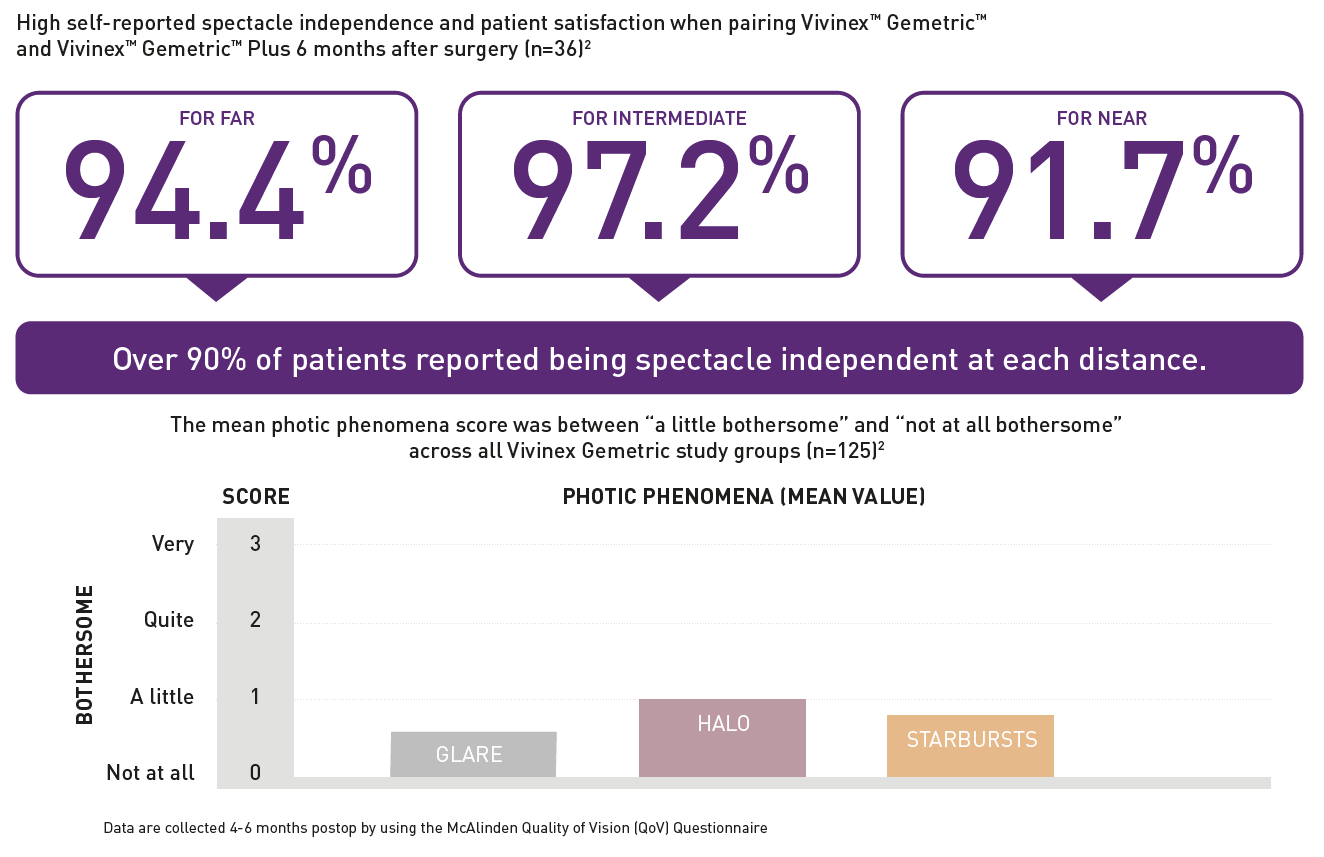Allgemein
Caractéristiques principales
- Acrylate hydrophobe sans glistening ¹, ², ³, ⁴, ⁵, ⁶, ⁷, ⁸, ⁹, ¹⁰
- Les bords texturés de l’optique permettent de réduire la dysphotopsie
- Risque de PCO (Posterior Capsular Opacification) réduit grâce aux bords carrés et un traitement de surface innovant
- Haptiques rugueuses texturées
- Diamètre extérieur de l’extrémité avant de l’injecteur 1.70 mm
- Transparence à long terme, basé sur des tests in vitro ⁹
- Plus de 90% d'indépendance visuelle ¹
Vers l`indépendance visuelle
Vivinex Gemetric permet une excellente vision de loin, une très bonne vision intermédiaire et une bonne vision de près.
Vivinex Gemetric Plus permet une très bonne vision de loin, une bonne vision intermédiaire et une excellente vision de près.
Les deux designs Gemetric peuvent être adaptés en fonction des préférences des patients pour la vision de loin ou de près.
Vivinex Gemetric Plus permet une très bonne vision de loin, une bonne vision intermédiaire et une excellente vision de près.
Les deux designs Gemetric peuvent être adaptés en fonction des préférences des patients pour la vision de loin ou de près.

Une large couverture visuelle grâce au pairing
L`approche pairing combine un implant Vivinex Gemetric et un Vivinex Gemetric Pluset offre ainsi aux patients un avantage visuel optimisé.

Plus de 90% d`indépendance visuelle
Une enquête post-opératoire a montré que plus de 90% des patients n`ont plus besoin de lunettes 6 mois après l`opération de la cataracte.

References:
1. HOYA data on file. CTM-23-029, HOYA Medical Singapore, Pte. Ltd, 2023 2. Miyata, A. et al. (2001): Clinical and experimental observation of glistening in acrylic intraocular lenses. In: Japanese journal of ophthalmology 45 (6), p. 564–569. 3. Auffarth et al. (2023) Randomized multicenter trial to assess posterior capsule opacification and glistenings in two hydrophobic acrylic intraocular lenses. Sci Rep 13, 2822. 4. Leydolt, C. et al. (2020): Posterior capsule opacification with two hydrophobic acrylic intraocular lenses: 3-year results of a randomized trial. In: American journal of ophthalmology 217 (9), p. 224-231. 5. Giacinto, C. et al. (2019): Surface properties of commercially available hydrophobic acrylic intraocular lenses: Comparative study. In: Journal of cataract and refractive surgery 45 (9), p. 1330–1334. 6. Werner, L. et al. (2019): Evaluation of clarity characteristics in a new hydrophobic acrylic IOL in comparison to commercially available IOLs. In: Journal of cataract and refractive surgery 45 (10), p. 1490–1497. 7. Matsushima, H. et al. (2006): Active oxygen processing for acrylic intraocular lenses to prevent posterior capsule opacification. In: Journal of cataract and refractive surgery 32 (6), p. 1035–1040. 8. Farukhi, A. et al. (2015): Evaluation of uveal and capsule biocompatibility of a single-piece hydrophobic acrylic intraocular lens with ultraviolet-ozone treatment on the posterior surface. In: Journal of cataract and refractive surgery 41 (5), p. 1081–1087. 9. Eldred, J. et al. (2019): An In Vitro Human Lens Capsular Bag Model Adopting a Graded Culture Regime to Assess Putative Impact of IOLs on PCO Formation. In: Investigative ophthalmology & visual science 60 (1), p. 113–122. 10. Nanavaty, M. et al. (2019): Edge profile of commercially available square-edged intraocular lenses: Part 2. In: Journal of cataract and refractive surgery 45 (6), p. 847–853. 11. Schartmueller, D. et al. (2019): True rotational stability of a single-piece hydrophobic intraocular lens. In: The British journal of ophthalmology 103 (2), p. 186–190. 12. Pérez-Merino, P.; Marcos, S. (2018): Effect of intraocular lens decentration on image quality tested in a custom model eye. In: Journal of cataract and refractive surgery 44(7), p. 889-896. 13. Miyata, A. et al. (2001): Clinical and experimental observation of glistening in acrylic intraocular lenses. In: Japanese journal of ophthalmology 45 (6), p. 564–569. 14. Pérez-Merino, P.; Marcos, S. (2018): Effect of intraocular lens decentration on image quality tested in a custom model eye. In: Journal of cataract and refractive surgery 44 (7), p. 889–896 15. Schartmuller, D. et al. (2019): True rotational stability of a single-piece hydrophobic intraocular lens. In: The British journal of ophthalmology 103 (2), p. 186–190.
